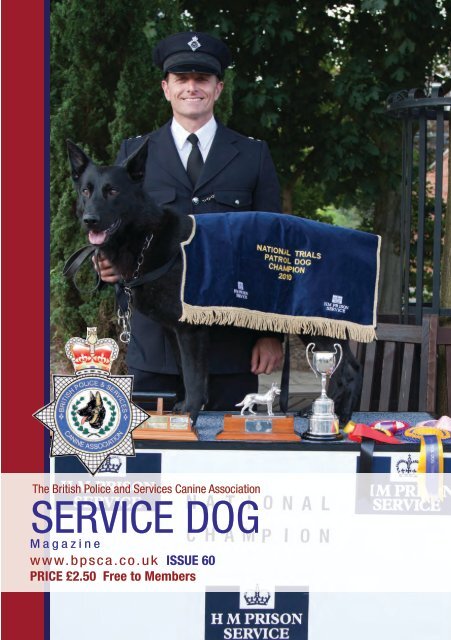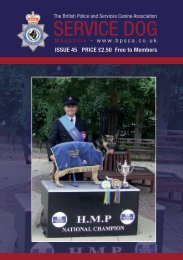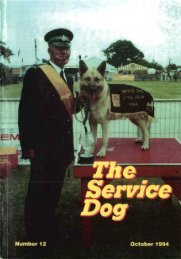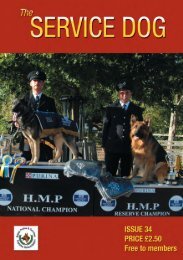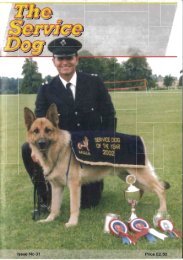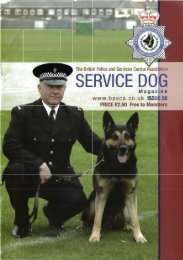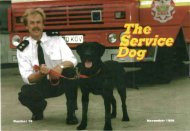SERVICE DOG - BPSCA.net
SERVICE DOG - BPSCA.net
SERVICE DOG - BPSCA.net
- No tags were found...
Create successful ePaper yourself
Turn your PDF publications into a flip-book with our unique Google optimized e-Paper software.
Re Join andNew Members- from 29 August 2010Members:Mr D. Payne, Mr G. Sowter, Mr A.Parker, Mr J.J. Fitzpatrick.Miss J. Johnson, Mr B. Welch,Mr R. Jakeman,Associate Members:Mr N.T. Taj, Mr Jakobicki, Mr D. Dlugosz,Mr P. PrzystasI. Mr M. Maciaszek, Mr D.Jakobicki, Mrs A. Jakobicki, Mr R. Leah.Mrs J. Bayston, Mr T. Eaton, Mrs M. Eaton,Miss E.C. Beaumont. Mr J.A. Austin, Mr N.Dolman, Mr S. Kite, Mr N. Van der Wee.Mr M. Maskell, Mr K. Vatcher,A big thank you to all new andre-subscribing Members.<strong>BPSCA</strong>CommitteeElection of Committee MembersMembers:PresidentSteve Allen MBEChairmanSam MackayVice Chairman Ron StanleySecretaryDave FletcherMembership Secretary John WarbuttonAssistant Secretary Jackie RobertsonEditorKeith Long ISMTreasurerSteve FergusonWebsite Manager Andrew SandersonStand on Committee:Sam PerrieColin HuskinsJim NunnMark AdamsJohn DavidsonBritish InstituteofProfessional Dog Trainers(Security Division)For details of:SECURITY <strong>DOG</strong>HANDLER’SACCREDITATIONPlease contact:BIPDT Security Devision, TheHarrow, Tumbril Lane, Brockdish,Norfolk IP21 4JUTel: 01379 852499The Service Dog 5
Letter from CanadaI live in Bella Coola British Columbia in Canadaknown as a place with a high grizzly bearpopulation. I have always wanted to be helpfulin lowering high bear mortality in our valley, soafter years of training dogs, I decided to get aKarelian Bear dog. Since I got this little guy (notso little 60lbs), I have used him to track downorphaned bear cubs with the conservation officer,as well as a grizzly bear in a residential area. Myplans are to use him to track down darted bearsin the bush as well, as they usually run for a waysbefore the drug takes effect. Syut, my KarelianBear dog is able to track the bear down and allthe work is done with the CO Officer.Long used as hardy hunting dogs in northernEurope. The KBD is a perfect Partner in the workbeing conducted with government agenciesresponsible for bear management in remotehuman populated areas. “Syut” (Nuxalk forKiller Whale), is just a 10-month-old pup, but hislife is already planned out for him in the line upservice. He is amazing at finding bears already. Iam the one that is a learning. Fortunately, I havea teacher that analyses my work, and informs meon both bear and dog behaviour under certaincircumstances. In a couple of years I will writethis magazine again, and likely will have goodstories to share.Thank you for your informative magazine. Ienjoy it immensely.Ellie ArcherDetection DogsThe 9th Seminar on Detection Dogs is now out on the UK LEADS website.It is scheduled for 28th of February to the 2nd March 2011 at the Fire Service College, Moretonin Marsh, Gloucestershire, GL 566 The Service Dog
Ivan Balabanov Twice World Schutzhund ChampionIn May 2008 Ivan Balabanov came to the UKto present his first Seminar. Invited by EmunahCanine Training Solutions.Ivan grew up in Bulgaria, lived in Belgium forseveral years training with the French and Dutch.Ivan’s achievements and wealth of knowledgespeak for themselves.Ivan has decoyed and competed in Schutzhundand French Ring Sport, gaining many tophonours. Ivan now lives in Plant City, Florida. Ivanis the author the book “Advanced Schutzhund”,and he has made numerous training videosfor his company Canine Training Systems Ivanlectures all over the world on dog training bothsport and civil.The 2008 seminar was held at Carol and ArthurRivers beautiful grounds at Rivos Kennels inOxspring South Yorkshire, even though it wasvery cold and extremely windy (not so good forIvan as he had only brought summer clothes)despite the cold we all had a fantastic weekend.and we all took something positive from Ivan’smethods home with us. Ivan worked very hardin difficult circumstances and atrocious weatherconditions taking time to listen to and answerIvan is arguably the most decorated dog trainerin America. The first and only non-Europeantrainer to become a World Champion at theindividual competition. He holds two (back toback) World Championship titles !Winning Protecion Competitions for over 10years back to back!• 2009 AWMA (American Working MalinoisAssociation) Nationals IPO 3 Champion• 2008 AWMA (American Working MalinoisAssociation) Nationals IPO 3 Champion• 2007 FCI Torino, Italy All Breeds World Champion• 2007 FMBB Le Touquet, France BelgianShepherd World Champion• 2007 AWDF (American Working DogFederation) All Breeds Nationals IPO 3 Champion• 2006 AWDF (American Working DogFederation) All Breeds Nationals IPO 3 Champion• 2005 AWDF (American Working DogFederation) All Breeds Nationals IPO 3 ChampionThe Definitive Championeveryone’s questions.The last event was attended by Police Officersfrom many forces across the country and Irelandand also by people from all levels and disciplineswithin the dog training/working fraternity,And now Emunah is pleased to announce thatIvan has agreed to come back to the UK and islooking forward to presenting another Seminaron the last weekend in May, the Seminar willbe held at Damian O Donnell’s training groundnear Rye Hill, West Yorkshire. This time it willbe a three day event Day one and two willcover Ivan’s methods in Schutzhund, personalprotection and problem solving techniques ,Day three will be Ivan’s Specialist Police trainingMethods including Grip and Control withoutconflict, it will be the first time that these newtechniques will be demonstrated in the UK.Another exciting event will be the demonstrationfrom the newly formed UK Patrol and ProtectionDog Association; this will take place on the lastday (Monday).For further information on this Seminar pleasecontact Michelle birdieshell@btinter<strong>net</strong>.com.• 2004 AWMA (American Working MalinoisAssociation) Nationals IPO 3 Champion• 2003 AWMA (American Working MalinoisAssociation) Nationals IPO 3 Champion• 2001 USCA (United Schutzhund Clubs ofAmerica) German Shepherd Nationals IPO 3Champion• 2001 AWDF (American Working DogFederation) All Breeds Nationals IPO 3 Champion• 2000 AWDF (American Working DogFederation) All Breeds Nationals IPO 3 Champion• 2000 FMBB Homburg,Germany BelgianShepherd World Vice Champion• 2000 DVG America All Breeds Nationals IPO3 Champion• 1999 DVG America All Breeds Nationals IPO3 Champion• 1998 DVG America All Breeds Nationals IPO3 ChampionThe Service Dog 7
Discontinuation of ChaseBefore attempting to teach this exercise youmust first define what exactly is meant by it. Itcannot be correctly referred to as a “termination”which, of course would mean having to finishwhatever you were doing completely. Neithercan it be correctly referred to as a Recall whichis essentially the term used to call the dog tothe handler from one of the “Stay” positions,where it must adopt the “Present” positionbefore moving into the “Heel” position. Therecall is carried out by the use of three distinctwords of command. “Come”, “Sit” and “Heel”.It will be found that once the exercise has beenpractised for a while, the word of command“Sit” becomes unnecessary, even though theword of command will still be allowed to beused in competitionFor the purpose of training, the TerminationExercise can be broken down into three mainparts. The “Heel “ which is required for the initialapproach and control, the word of commandto chase; “Stop him” or “Get Him” to sendthe dog into the attack and the word “Leave”or “Out” to bring the dog back to the handler.For training purposes this latter part of theexercise can be broken down still further intotwo distinct parts, the first to order the dog tocease his attack on the baiter, and the secondto bring him back to his handler.Teaching the dog to drop flat on the word ofcommand “leave” and to practise this until it isalmost an automatic reflex action on the part ofthe dog has two main advantages. One, it putsthe dog into a static position and Two, it createsa state of reception in the dog for the handler’snext word of command which will be “Come”.If the dog has been correctly trained from thestart to carry out the “Down” position whilst onthe move, it will only take a matter of days toteach him to do so on the word of command“Leave” also. By the same token, if he has beencorrectly trained to carry out the recall from thestart then this too will not require any furthertraining.N.B/Because of the circumstances under whichthe word of command “Leave” is normallygiven, it may be worthwhile giving someconsideration to the use of a whistle insteadof the voice. It has a much more pe<strong>net</strong>rativesound than the handler’s voice and in anextremely noisy situation would be muchless likely to be drowned out.It must be remembered that the nearer thedog gets to his quarry the louder the noisefrom that quarry is going to be.8 The Service Dog
The argument that anyone else could blowa whistle and confuse the dog is such anunlikely proposition that from a practicaland operational point of view it is hardlyworth considering.Making the dog leave the baiter willingly isone of the problems that many trainers have. Itmust be recognised that biting a “criminal” isone of the activities for which dogs never needto be rewarded. In the normal guard dog thebite is the reward and almost every trainedguard dog would much prefer to bite ratherthan chase a tennis ball. Nor are they likely toforsake the opportunity to bite by the offer of apiece of meat. Even the attraction of a bitch inseason will normally come a very poor secondto the thrill and excitement of the chase and thebite. Therefore, in order to achieve a satisfactoryand effective result the dog must be taught oneof two ways.One way is by the use of the electric collar,correctly used, and ensuring that the level of theelectrical stimulus is not set too high. This willteach the dog that to carry on with the attackafter the word of command has been givenwill be very uncomfortable, and,therefore,notso enjoyable. The instinct of self preservationwill also kick in, and in the same way as thedog learns not to attack porcupines snakes andskunks in the wild, or to attack a piece of livecoal, or sniff a hot fire grate, it will learn to leaveon the word of command.This method has a lot of drawbacks, not everydog re-acts in the same way to an electricalstimulus. Some shriek with pain and shock atthe smallest tingle, whilst with others it hasbeen known to increase their endorphin levelsand almost as though they are regarding thestimulus as having been inflicted by the victim,actually increases their anger and aggressiontowards him.So there is a risk that this method may putthe dog off biting altogether or cause him tobite half heartedly and hesitantly which is hardlyconducive to the requirements of an efficient andeffective guard dog. On the other hand it mayturn your particular animal into an uncontrollablebite machine . Neither options are ideal.In order to convince the dog that he is not goingto lose anything or suffer a cessation of pleasurewhenever he obeys the word of command“Leave”, you must arrange things so that he iscompensated or rewarded for his response. Asthere is no pleasure more agreeable as far as thedog is concerned than biting the “enemy “ thenthe obvious and most logical thing to do is toprovide him with another opportunity to bite.At this point the trainer has to be absolutelylogical and extremely careful just how he setsup this situation . I have seen this manoeuvrecarried out by a handler or trainer on his owndog ; making him leave by baiting him witha bite pad held in both hands and “fed into”the dog’s mouth. Playing with him, laughinglyencouraging him and leading him away fromthe immediate area of the baiter.I have never considered it to be a good ideafor a handler to bait his own dog - for obviousThe Service Dog 9
easons – In fact I have always advised handlersto be extremely careful when training a guarddog – or any dog at all of a particularly bolddisposition, for that matter and not to indulgein “pulling” games with rubber rings or “Tug-ofWar” with any item at all.At first it may seem to be a fun activity, butthink about the position logically and carefully.All the time the dog is growling and tuggingplayfully on the object – no matter what it is,just consider what the dog is staring at as he“kills” it.It is NEVER the object he has in his mouthat that particular time that he is staring at, ohno - it is YOU.I am not saying that EVERY dog will build upfalse confidence and a desire to bite YOU simplybecause you are playing these games with it, butask yourself the question. How is a guard dogtrained to bite ? and how different is that fromwhat you are presently doing ?So the answer is, when teaching a dog toleave, use a secondary baiter to follow you andthe dog into the attack to provide another biteimmediately you command the dog to leave.Then switch back to the first baiter as, onceagain, you give the word of command to leave.Eventually the dog will leave immediately onhearing the word of command in the expectationof there being another “criminal” to bite. As youteach this exercise have the secondary baitermove progressively further and further awayfrom the first one, so the dog has to actually lookfor him and chase him after he leaves. Positionyourself further away too, so the dog is movingaway from the first baiter and towards you andthe second baiter. Other refinements may be tohave the secondary baiter situated near a securehide such as the cab of a vehicle, so that if thedog does not move after him quickly he loses him.All this training is based upon the dog havingbeen trained to carry out the basic requirementssuch as the Heel, the “Down” whilst on themove (sometimes referred to as the “Drop”)and the full recall ( including the “Present” andthe “Heel” to finish.There are some trainers who advocate the useof a tennis ball or some other item, which theythrow behind themselves as soon as the dogleaves and is coming back to them. Some evenhave the baiter throwing it as the handler givesthe word of command “leave” when teachingthe Discontinuation Exercise. This may be allvery well when training for a competition butan operational dog that will leave the quarrybecause he has thrown them a ball is not reallya sensible option now is it ?The rules for the exercise should be framed sothat TWO words of command are acceptable aswell as the dog’s name,these will be “Leave”and “Come”.As a further thought on the exercise, thepractice of allowing anyone to carry on chasingthe baiter after the word of command “Leave”has been given and then carrying out a “standoff” should not be allowed. The exercise is called“Discontinuation of Chase” and not the “Standoff” exercise. Similarly the practice of simplymaking the dog drop into the “Down” positionshould penalised and considered to be only halfof what is required. Any one using the excusethat they “don't do that” in their arm or Unitshould be ignored. Trying to suit everyone whenmaking out such a schedule is like a monkeytrying to sit on two stools at the same time andfalling in between them. If any Handler wishesto enter the competition then he must train hisdog to carry out the same exercises as everyoneelse. It isn’t exactly rocket science is it ?Whilst dealing with the Discontinuation ofChase it is a good idea to back up such trainingby practising it in conjunction with the “Trigger”ExerciseMost trained guard dogs will attack ifthreatened verbally or physically or if thesuspect or assailant runs away. But there maybe times when a dog is required to attack amotionless person; someone quietly threateningthe handler without, apparently, posing anyobviously recognisable threat as far as the dog10 The Service Dog
is concerned. The suspect may be quietly talkingto the handler and then suddenly attempt toproduce a concealed weapon.In order to cover this sort of situation the dogmay be taught to react immediately to a “trigger”word of command. This is usually the same wordof command that the handler would use in orderto send the dog into the attack. When used as a“trigger” word the dog will react to it instantlyand forestall any threat of violence. It makes nodifference that the suspect is standing perfectlystill and motionless, and apparently presentingno threat whatsoever to the dog or the handler.Once the “trigger” word of command is givenin a quiet, conversational tone of voice the dogwill immediately explode into action.The exercise is carried out on the training area.The handler stands with his dog at heel behind aline marked on the ground. The dog is wearinga reversed choke chain fitted high on the neckbehind the ears and held into position with asplit ring. The training lead is clipped on to thechoke chain and there is no other collar. At agiven signal, the baiter, armed only with a lightbaiting stick, proceeds to walk slowly backwardsand forwards across the front of the dog ata distance of about two or three paces. Anyattempt by the dog to attack the baiter withoutany word of command being given is immediatelyand quietly checked.( No word of command orverbal chastisement being necessary.)The baiter gives no reaction to these attacksor corrections at all, but strolls nonchalantlyto and fro. He waits until the dog is perfectlysettled down again and at ease. Once the dogis sitting quietly and under full control he passesacross the front of him a further three or fourtimes,then after a suitable number of passes hewill indicate to the handler that he is ready tostart. He will usually give this indication with anod of his head as he is moving from right to leftand when his left arm is nearer the dog. This willmean that he is going to bait the dog the nexttime he comes past when his right arm, (uponwhich the padded sleeve would normally beworn) will be nearer the dog. The handler givesthe word of command “Watch Him” quietly andalmost conversationally.Normally the dog would then look around fora running fugitive or, at least, someone whowas inciting or threatening him or his handler.But the baiter gives him no time to do this. Atprecisely the same instant as the handler givesthe “trigger” word the baiter prods the dog inthe left flank with the baiting stick and runs offto his hide. This will have the immediate effect ofshocking and aggravating the dog and triggeringhim off into an almost frenzied attackWhen the baiter has disappeared from viewthe handler gives the word of command “Leave”and brings the dog back to the heel position. Assoon as he feels that the dog has settled downagain he signals to the baiter and the wholeexercise is repeated. The dog is kept strictlyunder control until the “trigger” word is given.After a few repetitions of this exercise, it willnot be necessary for the baiter to prod the dog,threaten him or his handler, or to jump back inorder to incite him. On hearing the “trigger”word the dog will anticipate the baiter’s reactionsand initiate the attack himself. In fact the baiterwill have to be on the alert in order to avoidbeing bitten. At this stage the broad leather collarcan be put back on to the dog and the traininglead clipped on to that so that the dog is notaccidentally checked as he is “triggered off”.Variations of this exercise can be carried outfrom time to time. There are no restrictionsupon the number of times it can be repeated.The more often it is done the more control thedog is taught. It can even be incorporated intohis normal sleeve, padded suit or muzzle attackexercises in order to increase the standard ofcontrol the dog will have whilst carrying themout. This exercise should be carried out fairlyclose to the hide. There is no sense in makingthe baiter run fifty yards every time. There is notgoing to be a chase.Et Canes et Homines DocemusSam PerrieThe Service Dog 11
One of the third litter ofpuppies to be bred especiallyfor and by the MODPolice[Picture: Leading Airman(Photographer) Dan Hooper,Crown Copyright/MOD 2010]Our YoungestRecruitsThe latest results of MDP’s breeding programme of Malinois dogsThe first MOD Police Service dogs to be bornto the police dog unit at HMNB Devonportwere pictured last month, aged three weeks,as they learned to walk and eat solid food forthe first time.The 12 Belgian Shepherd Malinois pups arethe police dogs of the future and are destinedto patrol MOD assets worldwide, but for nowthey are one of the main attractions at the base.Sergt Matt Robertson, supervisor ofthe police dog unit in Devonport, said:“Not surprisingly, people are queuing up tocome and see them. The puppies are learningto walk and their eyes are opened fully.“They have all put on a healthy weight andare very well and thriving. We are all very proudof them and their mother Willow.”This is the third litter of puppies to be bredespecially for and by the MOD Police, with theprevious two taking place at the breeder’s kennelsand at the MOD Police headquarters.The police dog unit previously bought inGerman Shepherds as new recruits, but theyhave increasingly become susceptible to healthproblems which shortened their working life.It was decided that the best way to guaranteegood quality, healthy dogs and provide value fortaxpayers’ money was to breed in-house andswitch to Belgian Shepherds of the Malinoisvariety.Sergt Robertson said: “The breedingprogramme guarantees us a high standard ofdog, we know the origins of the dogs and theirge<strong>net</strong>ic history and their temperament.“This breed is already known for its sociablecharacter and they are easy to train with a highlevel of fitness. The breeding programme meanswe can trace their lineage and parentage - thefather is the same in both litters and the mothersare sisters.”Once the pups reached eight weeks, they begandevelopment training – a major step towardsplaying a crucial role in the UK’s security.12 The Service Dog
Dylan makes a findDylan, whose tail was wagging furiously in eageranticipation. Then, the door swung open andthey were instructed to enter by the Course Tutor.PC Jones, one step inside the room kept wellback, allowing his dog to carry out a ‘free search’,covering all areas; Dylan soon homed in on thechest of drawers, and then froze, rooted to thespot. This was a good indication.PC Jones threw the toy which Dylan snatchedup eagerly and rushed into the hallway, wherehe was praised by his handler and made a fussof. A lot of pummelling and stroking followed.Playfully, Dylan whizzed down the corridor, earsflapping, having the time of his life, chasing thetoy. He skidded to an abrupt halt at the end ofthe hall and then raced, full pelt, back up to hishandler. It is clear, even at this stage, that this isboth a puppy and a potential explosives searchdog in the making.All the other dogs took it in equal turnssearching all 4 bedrooms with pretty muchequal success.After they’d all had their turns, PS Tobias said:“We are now at the level of looking for a goodindication. There is no real involvement from thehandler at this stage of ‘free searching’. LaterReward is important16 The Service Dogon we’ll teach methods for ‘systematic search’;the handler will then help the dog by usingbody language.“You saw Finn in Room 2 getting excited.He’d smelt something but because of heating,draughts and body movements the scent waftsaround. He found it though.“We next get the dogs used to distractionssuch as audio tapes with different noises suchas explosions and kiddies playing with toy guns.I think we’ll add the clicking of cameras to thisrecording after today!”The steady yet fun approachPS Tobias explains that by bringing new dogs onslowly, keeping the fun element, they remaininterested. “You can see each dog waiting for hiscommand. By bringing them on nice and slowly,means you can introduce the control element.It is all a process of control and repetition.”StaminaThese young dogs look extremely healthy andwill gradually build increasing levels of stamina.By the end of the course, the dogs will also bemore ‘streetwise’.What next?Before Talk Through left the course to continue,PS Tobias added: “The handlers write theirassessment each day and then PC Ken Angusand I will compile our observations. As CourseDirector, I’ll have to verify them.“Starting next Monday, we are at Portsmouth.We’ve arranged access to a shopping centre andmilitary establishments to give the dogs a varietyof experiences. In the coming weeks we’ll go tobuilders’ yards, railway stations, an airport usingthe hangars, there will be ships and ferries, HMSWarrior, Haslar Hospital and Portsmouth FCfootball ground – all sorts of venues.”Four months later and the training is over.How did they do?Inspr Bruce McMurchy, Ops Support AgencyDog Officer said: “We had one dog and handlerwho passed the course in its entirety. As youindicate in the article, we set high standards.We need to, if our dogs are to be effective anddo the job required of them. It is stiff but thatis all to the good. We are happy to have oneextremely good team go through to qualify asExplo qualified dog and handler and they willbe put to immediate use within their Division.”
<strong>BPSCA</strong> ANNUAL TRIALSANNUAL TRIALS 2nd JULY 2011ENTRY FORMPLEASE COMPLETE IN BLOCK CAPITALSDress CodeThe attention of all competitors is drawn to the Dress Code as shown in the <strong>BPSCA</strong> CompetitionRules. These are to be strictly adhered to.NB Denims, coloured or white training shoes or any kind of dress which may reflect unfavourablyupon themselves or their organisation will not be acceptable. The Chief Judge will be empoweredto refuse anyone entry whom he considers to be unsuitably or improperly or untidily dressed. Theywill not be allowed to take any part in the trials.. Any competitor who has any doubts as to thesuitability of their preferred dress is strongly advised to ask beforehand.All dogs entered must be presented in a healthy, clean and well groomed condition . There is noexcuse for any handler having an unkempt and scruffy dog and any of the Judges coming acrosssuch an animal is empowered to refuse it entry.18 The Service Dog
The 40thPrison Service Dog Trials 2010The Prison Service held their 40th National PrisonDog Trials at HMPSC Newbold Revel (SEPTEMBER8th, 9th, 10th and 11th). by the kind permissionof Michael Spur.The Prison Dog National Trials is a competition,which brings out the best dogs the servicehas to offer and covers most of the service’suse of dogs in their varied professional roles.These trials represent the work carried out bythe many handlers and their canine partnersworking within the prison service in England andWales and Northern Ireland. It has become thelargest competition of all the Services and it alsorepresents the largest amount of dog handlers.The prison service, started with dogs in 1967and the trials started in 1968 with one yearwithout trials due to budgetary measures withinthe service. On that occasion, all the prisondog handlers clubbed together to continuethe competition, which took place from HMPWinchester, who provided the venue and largelyfinanced by the dog sections by running rafflesand various other fund raising activities... Thiswas quite a feat considering that there wereonly eight dog sections in the UK at that time.The camaraderie then and now is the best inthe Prison Service. Even so, the competition isquite fierce everyone wanting to do well andhoping their dogs and their selves perform totheir capability as mistakes are costly.The competition is over four days covering allthe tasks that the dogs and handlers are requiredto fulfil in their operational roles. i.e. Patrol dog,Passive drugs dog and Active drugs dog. Thisyear’s competition proved, once again, to be ofan exceptionally high standard.Saturday is the main day for the friends,family and prison representatives This is the dayeveryone can watch the obedience and criminalwork..it is also the day that the guests can watchthe drugs dogs at work. The finale, once all thescores are in, takes place in the auditorium,where winning competitors receive their trophiesand awards. It is also the time when individualemeritus awards are given to members of thedog section.20 The Service Dog
Michael SpurrChiefExecutiveOfficerAlthough prison dogswere introduced in 1967,this year is the 40thNational prison dog trials,as well as being my firstyear to have the pleasureof hosting this event.Dog handlers perform an importantprofessional role within the service, and thisevent brings together dogs and handlers fromacross the estate to demonstrate their skillsand their professionalism in competition witheach other.It is also good to see the support that thisevent generates from prison management, staffas well as families and members of the public.I look forward to meeting you and hope youall have an enjoyable day watching what I hopewill be a keen competition.Patrol dog trialsMan work exercisesEach team will be required to apprehend andarrested criminal and escort him to an area ofdetention is directed by the Judge.SCORINGChase and Attack,100 pointsOverall Control20 pointsSearch20 points.Escort10 points.Chase and recall60 points.Overall Control40 points.Stick attack,40 points.Overall control20 pointsGun attack,30 points.Overall control20 pointsSearch for property exerciseRetrieval of all articles 36 points.Method of work in the dog. 14 pointsSearch for person exerciseThe dog will be sent to quarter and search a givenarea in a methodical and enthusiastic mannerwithin a time limit of 10 minutes. When the doghas indicated the hidden person(s) by barking,the dogmas remain there until the arrival ofthe handler. Any biting or deliberate contactwill be penalised.50 points for finding each person 100 points.Method of searching,30 pointsObedience programEach team will be required to carry out a seriesof action designed to incorporate all the basicwords of command and movements as laid downin the standard of efficiency.he’ll 340 points.Distance control30 points.Retrieve30 points.Speak anchorman10 points.Send away and recall 50 points.3 foot jump 10 points.Long jump20 points.Long down20 points.Drug dog trials.Scent recognitionThe dog is expected to undertake a timesent recognition exercise, not responding todistractions but indicating the hidden drug ina safe and accurate manner that can be readby the handler.Target substances,100 pointsMethod and indications 250 points.ControlThe dog is expected to demonstrate that it isunder control both on and off the lead, beingable to adapt both the state and down positions,as well as being capable of being left unattended.He’ll work100 points.Recall25 pointsDown stay50 points.Operational searchThe dog will be expected to clear designatedareas or people in a safe and accurate mannerwith clear indication of the hidden drugs thatthe handler can readTarget substances,100 pointsMethod and indications 250 pointsThe Service Dog 21
Historical notes, cups andtrophiesThe Fowler Salver.Presented in 1979, by the then deputy directorgeneral of the prison service, Gordon Fowler,and is awarded to the individual with the mostconsistent and professional performance overthe yearThe Brister Trophy.Presented in 1984, by the then deputy directorgeneral of the prison service, Bill Brister, and isawarded for specialist work with prison dogsThe Lakes Trophy.Presented in 1989, by the then deputy directorgeneral of the prison service, Gordon Lakes, andis awarded to the best dog section of the yearThe Uzzell TrophyPresented in 1991, by the then Gov of the dogsection, Jonathan Uzzel and is awarded to thenovice handler who has gained the highest mark.At this year’s local trialsThe Kitcher Trophy.Presented in 1974, by Mrs Kitcher in memoryof her late husband, Officer dog handler JohnKitcher, HM Prison Winchester. it is awardedto the youngest patrol dog competing in thisyear’s national trialsThe Manders TrophyPresented in 1970, by Mrs Susann Mandersin memory of her late husband, Senior officerdog handler Ray Manders, HM prison Leeds .itis awarded to the oldest patrol dog competingin this year’s national trials.The Bob Perry. TrophyPresented by Bob Perry, on his retirement asarea manager in 2007 and is awarded to (inthe opinion of the judges). The best presenteddrug dog teamThe Captain Davies CupPresented in 1968, by the then governor ofManchester prison, Capt Davis, and is awardedto the Reserve patrol dog championThe Munsell TrophyPresented in 1968, buys the then inspectorgeneral of the prison service, Brig national, andis awarded to the National patrol dog championThe Day TrophyPresented in 1982, by H Day awarded to theteam for the best operational successThe Martin Nary Trophy.Presented in 2002, by Martin Nary, the thendirector-general, for the best discipline brokedog teamThe McKenzie Trophy.Presented by Keith Mackenzie, retired head ofMetropolitan police dog school, in 2005 it isawarded to the reserve acted drug dog championDSU TrophyPresented by the drug strategy you on it in2005 it is awarded to the reserve passive drugdog championPeter Atherton. TrophyPresented by Peter Atherton, deputy directorgeneral, in 2005. It is awarded to the Nationalactive drug dog champion.Phil Wheatley Trophy.Presented by Phil Wheatley, Director-General,in 2005. It is awarded to the National passivedrug dog championThe Watson Jackson CupPresented in 1988, by Mike Watson Jackson, onhis retirement as governor of the dog section,and is awarded to (in opinion of the judges).The best presented patrol dog teamThe Metropolitan Police Baton.Presented in 1969, by the Metropolitan policedog section and its awarded to the team withthe highest marks in the “search for property”exerciseThe Parr CupPresented in 1969 by Sir Stanley Park, the thenChief Constable of Lancashire police, and isawarded to the team with the highest marks inthe “ search for person” exerciseThe Heslop TrophyPresented in 1974, by Mrs Cecil at in memoryof the late husband, Sgt Jeff Kessler of theNorthumberland police, and is awarded to thewinner of the obedience in agility section ofthe trials.The Coupland CupPresented by Derek Copeland on his retirementas chief officer from the dog section in 1993.It is awarded to the winner of the “manwork”section of the trialsThe Sir Richard Tilt Drug Detection DogTrophyPresented in 2001, by the retired directorgeneral, and is awarded for the most significantcontribution by a drug detection dog team inthe fight against drugs in prisons.22 The Service Dog
The Service Dog 23
FaEleclighK-• L• L• E• MILIT• UTILICooler in SummerLintran Professional RangeTACTICAL, POLICE, FIRE & RESCUE,SECURITY <strong>SERVICE</strong>SMade in BritainWarmer in WinterSince 1988 Lintran has served the professionals including H.M. Services. Not: 1, 10 or 100 but 1000’s provided -from the heat of Afghanistan, Diego Garcia, Indian Ocean and Gibraltar to the cold of Iceland for Icelandic Police.From the North of UK, Lothian & Borders Police to Southern Counties of Avon and Somerset Police to MetropolitanPolice, British Transport Police and Belfast and Dublin security & Defence Animal Training Centre.Pleased to fit out up to 150 vehicles for the RSPCA presently.& the list goes on!Tel 01673 885959www.lintran.co.uk<strong>DOG</strong>BOXESCooler Hygienic dog boxes for over 21 years, aschosen by RSPCA new national fleet of vehiclesCNeouadforThwaondigitytoanExample shows Vivaro van with built-instorage - 3 GSD size compartmentsabove wheel arches, hand washbasin, electric fan, auxiliary batteryand light beacons to meet all securityrequirements.VANFIT-OUTSFleet of vans recently completed for UK BorderPatrol at Channel Tunnel. These units in TransitConnects were designed with flexibilty in mind tohold either 3 GSDs, 3 labs & 3 spaniels or 6spaniels all in one van.Tel 01673 885959 www.lintran.co.uk Fax 01673 885956 BrentwoodF• V• VC• E
ninrGive your dog and handler the edgewith Lintran Tactical RangeHealth & SafetyLINTRAN TACTICALssFansElectrical and/or manual fans andlightbars supplied and fitted. All colours.K-9 VEST FEATURES• Load-bearing D-rings at the shoulders and hips• Low-profile drag strap• Easy to adjustOptionsCOVER YOUR ASSETTS- DUTYTORCH CAMERANew rechargeable torch with maxoutput up to 200 lumens with theadded benefit of latest 3GP videoformatThe duty light camera is light, durable,water and shock resistant and can fiton to an officers belt.. The built indigital video recorder with 2GB capacityis easy to use and allows the officerto record the events as they took placeand” cover your assets” later in court.• MILITARY • LAW ENFORCEMENT • SEARCH & RESCUE • DIVING • HUNTING • OUTDOOR• UTILITY • HOME USEA professional kit is available which includesall the necessary emergency stabilisationfirst aid items needed when out in the field.• Ballistic/StabShankResistantPackages:Level I and IIIA• Re-usable coolpacks• Fully adjustable:One size fits all60-110lb dog• Replaceable elastic andballistic bellyband• Removable frontchest protector• Removable IDpatches• or just kick& stab onlyRange of tactical dog leads nowavailable including, Fast Capture,Quick release leads and muzzlesExtremeBeamFULL RANGE OF TACTICAL TORCHES• Viper • Web-Tex• Viper • Extreme Beam • Julius K9Combat K9 • Extreme Beam• Elite K9 • John Humphris Rangetwood House, Lincoln Road, Faldingworth, Market Rasen, Lincs LN8 3SF
Do you have any questions for our Vets Corner expert, or would youlike to see something covered in a future issue? If so, contact theeditor with your questions and suggestions.Vets CornerByPhilip KilkennyCare with Anti-FreezeEvery year the Veterinary Poisons InformationService (VPIS) releases figures detailing thenumbers of animals poisoned by variouscommon toxins, alongside the outcomes of theseincidents. One very striking increase over the lasttwo years has been the incidence of antifreezepoisoning (ethylene glycol). Although full figuresare not available yet for 2010 early indicationssuggest both a further increase in both thenumber of cases and the number of fatalities.It seems reasonable to assume that the recenthard winters we have experienced over the last3 years compared with previous mild winterweather may have something to do with, thisindeed during the cold spell of December 2010we saw 3 cases (2 cats and 1 dog).Anti-freeze is an extremely dangerous poisonto domestic animals, not only is it very toxic butit is also unfortunately very sweet tasting & veryattractive to dogs and cats. Only small amountsare needed to do serious damage even whenthe product has been diluted. Any spillages thatoccur when diluting such products or whenfilling the engine reserves must be mopped upat once and the bottle should also be securelycapped and placed out of reach of any inquisitivepets. Ethylene Glycol causes acute kidney failureand any suspected cases need to be seen verypromptly. If caught very early intravenous alcoholgiven alongside appropriate fluid therapy can bevery effective as it binds to the same receptorand blocks the uptake of ethylene glycol. This isprobably the only circumstance in which I wouldadvocate giving alcohol to a dog! And a bottleof 60% Russian vodka sits permanently in ourdrug safe awaiting such emergencies (we usedto keep it on the shelf but it drew too manysuspicious looks from clients!).26 The Service Dog
CompetitorsPATROL <strong>DOG</strong>Off. L. Carnighan Charlie FranklandOff. S. Bar<strong>net</strong>t Loki WoodhillOff. B. Wincott Maxwell Long LartinOff. A. Brown Blade WakefieldOff. S. Broadist Bailey ManchesterOff. B. McCourt Texas MaghaberryOff. A. Robinson Rosco MaghaberryOff. I. Garmston Duke Full SuttonOff. J. Walsh Edo NDTSGOff. T. Kindall Rudy BelmarshOff. C. Young Mido WhitemoorPASSIVE DRUG <strong>DOG</strong>Off. M. Butler Bruno The VerneOff. A. Mowbray Ben Stoke HeathOff. S. Hyde Bruce WaylandOff. P. Nicholson Bruno NottinghamOff. D. Smythies Maddie Isle of WightACTIVE DRUG <strong>DOG</strong>Off. S. O’Connor Jack NWASTOff. S. Crickmore Alfie BureOff. G. Sowter Glen North Sea CampOff. C. Warren Cassie Brinsford28 The Service Dog
H.M. Prison Service40th National Prison Dog Trials 2010OfficialsTrials Director Governor S.J.K. Allen, MBE NDTSGChief Judge Principal Officer J.Colley NDTSGTrials Coordinator Senior Officer J. Stiff, MBE NDTSGSearch for Person and ObedienceJudge: Senior Officer R. Bamford HMP Full SuttonSteward: Senior Officer J. Sheehan HMP ManchesterSearch for Property and Criminal ExercisesJudge: Senior Officer I. Fletcher HMP WhitemoorSteward: Senior Officer S. Hooper NDTSGPassive Drug Dog SearchJudge: Senior Officer P. Bowyer East of EnglandSteward: Officer C. StathamNorth WestActive Drug Dog SearchJudge: Officer S. Morris East MidlandsSteward: Senior Officer C. Gameson West MidlandsThe Service Dog 29
Scoreboard Nationals30 The Service Dog
s Passive and ActiveThe Service Dog 31
Scoreboard Nati32 The Service Dog
tionals PatrolThe Service Dog 33
WinnersandRunners Up34 The Service Dog
The Service Dog 35
36 The Service Dog
The Service Dog 37
Presentations38 The Service Dog
tationsThe Service Dog 39
Present40 The Service Dog
tationsThe Service Dog 41
Present42 The Service Dog
tationsThe Service Dog 43
British Police and Services Canine AssociationAPPLICATION FOR ASSOCIATE MEMBERSHIPMr/Mrs/Ms/Miss……Initial…… Surname…………………………………………………………Occupation:…………………………………………………………………………………………..Address:…………………………………………………………………………………………………………………………………………………………………………………………………………Town: …………………………………………………………………………………………………County:………….……………………………………………………………………………………Country: ………….………………… Post Code:…………………………………………………..Tel No. (Daytime)………………………… (Evening)……………………………………………...E-mail: ………………………………………………………………………………………..………Signed:…………………………………Date:……………………………………………………....PROPOSED BY:Full Members Name…………………………………………………………Membership Number…………Expire Date:…………………………………………………..Associate Membership: (*Delete as applicable)£15.00 per annum*£50.00 per five years*Please make cheques payable, in sterling, to B.P.S.C.A.Please forward to: The Membership SecretaryBritish Police and Services Canine AssociationMr J Warbutton6 Meadway CrescentSelby, North Yorkshire, YO8 4FXTel: 07841 472 542email: johnbpsca@aol.comMore information available at www.bpsca.com44 The Service Dog
British Police and Services Canine AssociationAPPLICATION FOR MEMBERSHIPMr/Mrs/Ms/Miss……Initial……..Surname…………………………………………………………Address:…………………………………………………………………………………………………………………………………………………………………………………………………………Town: …………………………………………………………………………………………………County:………….……………………………………………………………………………………Country: ………….………………… Post Code:…………………………………………………..Tel No. (Daytime)………………………… (Evening)……………………………………………...E-mail: ………………………………………………………………………………………..………Name Force/Unit:.....................................................................................................................Rank (where applicable):..........................................................................................................Specialised Service Dates........................................................................................................Course Qualifications (may be required):..................................................................................Signed:....……………………………………................................. Dated:…………………………Membership: (* Delete as applicable)£15.00 per annum*£50.00 per five years*Please make cheques payable, in sterling, to B.P.S.C.A.Please forward to:The Membership SecretaryBritish Police and Services Canine AssociationMr J Warbutton6 Meadway CrescentSelby, North Yorkshire, YO8 4FXTel: 07841 472 542Email: johnbpsca@aol.comMore information available at www.bpsca.comThe Service Dog 45
Hip dysplasia in working dogs,its prevention and detectionDogs provide a wide range ofsecurity roles from the detectionof explosives in Afghanistanto general “law enforcement”.Orthopaedic injuries in thesehigh performance athletes canbe costly in lost function andin particular the effects of hipdysplasia can be catastrophic inworking animals.Hip dysplasia is one of the mostcommon causes of hindlimblameness in dogs. The conditiondevelops as the puppy growsand results in “laxity” of the hipjoint. Detection of this laxityat an early age (from 16 weeks)using the Penn HIP techniquehas been shown to be the mostaccurate way to determinewhich dogs will suffer arthritisin the future and so both avoidcostly training of dogs thatwill have to be retired earlyand plan an effective breedingprogram to reduce the risk offuture generations sufferinghip dysplasia. If hip dysplasiais detected before 20 weeks ofage a simple procedure calleda Juvenile Pubic Symphiodesiscan be performed which hasbeen shown to be effectiveat improving the long termfunction of dogs with hipdysplasia.Ridge Referrals are one of ahandful of clinics in the UKthat are licensed to performthe Penn HIP technique. Thetwo pictures to the right showradiographs of a dog’s hips.The first shows the “standard”view of the hips and the secondshows the laxity demonstratedwhen the radiograph is takenusing the Penn HIP technique.It is this measure of laxity thatis so important to determinewhich animals are susceptibleto further arthritis.Patrick Ridge holds the RCVScertificates in Small AnimalSurgery and Radiology andruns Ridge Referrals in SouthDevon. Ridge Referrals is areferral practice specialisingin all aspects of joint diseasemanagement in cats and dogsand is one of only a handfulof practices licensed in theUK to perform the Penn HIPtechnique.
HD Progression 1HD Progression 2HD Progression 3X rays of the progression ofarthritis in a Golden Retrivercaused by hip dysplasia, imagescourtesy of Penn HIPIf you would like to speak toPatrick about this or any otheraspect of canine orthopaedicsplease call 0788 4436493,Email: surgery@ridgereferrals.co.ukor visit our websitewww.ridgereferrals.co.uk


